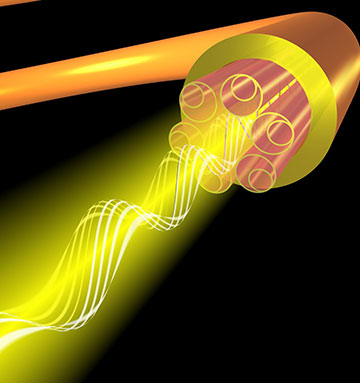
Researchers have shown that this “nested” antiresonant fiber, containing six glass tubes with smaller tubes inside them, can transmit light with a polarization purity approaching that of vacuum. [Image: University of Southampton]
Maintaining light in a pure polarization state is essential when using interferometry to make ultra-precise measurements of length, time or other quantities. This can be done with optical fibers, but gold-standard purity currently requires light to be channeled through a vacuum—which is too costly and impractical for all but the most specialist applications.
Now, researchers have shown performance approaching that of a vacuum using “antiresonant” optical fiber made from a number of carefully designed hollow glass tubes arranged around an air-filled core, as opposed to the glass-filled core of standard fibers (Nat. Photon., doi: 10.1038/s41566-020-0633-x). They say that this technology could prove a boon for interferometric sensing and might even lead to gravitational-wave detectors with arms an order of magnitude longer than today’s leading observatories.
Fiber limits
Impressive as it is in carrying vast amounts of data from one side of the world to the other in a fraction of a second, ordinary glass fiber is not suitable for the most precise gyroscopes or the frequency combs used to set time standards, for example. In part, that’s because tiny variations in the density of glass scatter light in random directions and transfer power from one orthogonal polarization mode to the other—so limiting the polarization purity of light passing through the fiber.
Scientists have developed fibers with birefringence, which limits coupling between polarization modes by forcing the modes to travel at different speeds. But there nevertheless remains a theoretical lower limit on this coupling for standard single-mode fiber—a few parts in 108 for every meter of fiber.
Minimizing loss and polarization coupling
Francesco Poletti and colleagues at the University of Southampton in the U.K. have shown in the latest work that they can better this limit by at least two orders of magnitude using a hollow-core antiresonant fiber. Their fiber contains glass tubes positioned around its circumference with dimensions carefully chosen so that they couple to the light’s higher spatial modes. That leaves a single spatial mode in the core, with its two degenerate polarizations propagating almost entirely through air.
One of several groups working on this technology, Poletti and co-workers report how they measured polarization coupling for two different types of antiresonant fiber. One, consisting of seven tubes with an average diameter of 21 micrometers, surrounding a core twice as large, achieved a coupling of just 3×10–9 m–1. The other, a “nested” design, is a similar size altogether but has six slightly bigger tubes, each of which contains another smaller tube inside it. This design got down all the way to about 10–10 m–1, although only over quite a limited range of wavelengths.
As Poletti explains, these nested tubes also serve to reduce losses by introducing more surfaces inside the fiber that can reflect light back into the core—the tubes’ thicknesses chosen precisely so as not to resonate with the light. This particular fiber had a loss of 3.3 dBkm–1, compared to the 0.28 dBkm–1 reported for a similar fiber by the same group at the Optical Fiber Communications conference in San Diego, USA, in March. But Poletti is confident that he and his colleagues can tweak the design so as to minimize both losses and polarization coupling at the same time.
Interferometric sensors and more
The Southampton researchers are now working with other groups on various possible applications of the technology, including novel sensors and new ways of delivering entangled photons. Although the antiresonant fiber is currently quite expensive to produce, being drawn in a university facility, he reckons it might be possible to bring its cost down to around that of commercial polarization-maintaining glass fiber, if produced in large enough volumes. “There is more than one company that is planning to launch sensors and devices based on this technology,” he says.
Beyond that, “one dream scenario”, as he puts it, would be to use the polarization-pure fiber to make much bigger gravitational-wave interferometers. The world’s current leading facility, LIGO, in the U.S., bounces laser beams off mirrors at the end of evacuated tubes 4 km long. But Poletti reckons that the use of fiber—which is much narrower than the tubes and would therefore maintain a vacuum more easily—could yield interferometer arms as long as 40 km. Although reluctant to speculate on the scientific merits of such an enormous detector, he estimates that it could be built within as little as 10 years.
